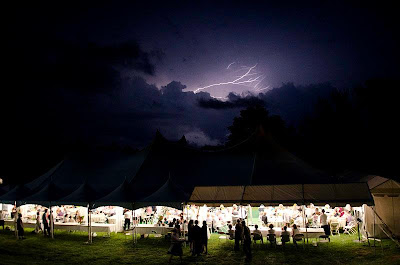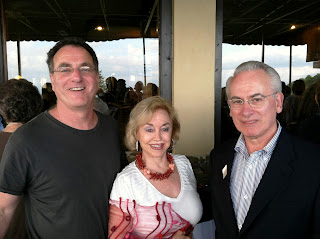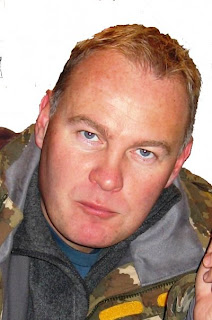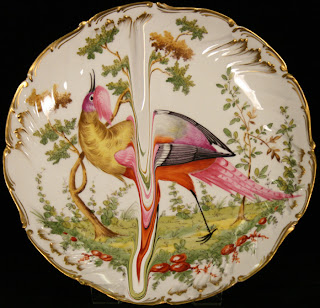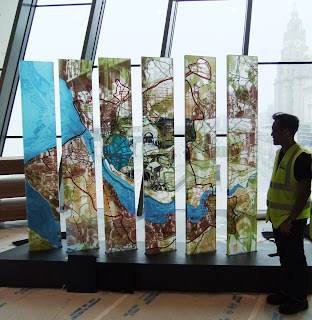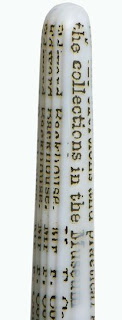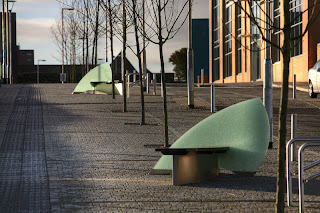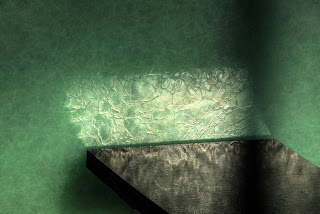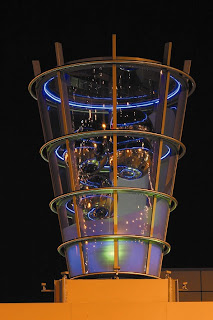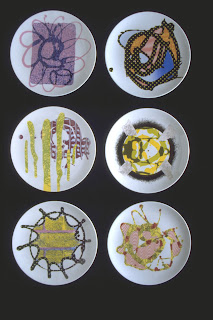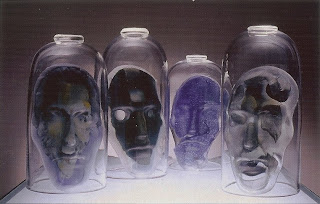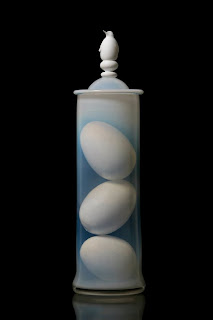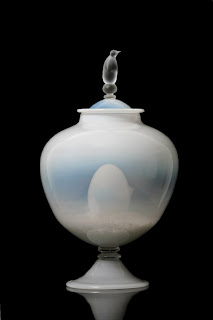>
 |
| “Envy” Tim Tate and Marc Petrovic; Cast and Blown Glass, Metal, Video |
The artist team of Tim Tate & Marc Petrovic are an artistic powerhouse duo! Tonight their exhibit “Glass Secessionism” opens at the Mesa Contemporary Arts Museum.
GLASS SECESSIONISM
- When:
- Friday, September 14, 2012 – Sunday, January 6, 2013
- Where:
- Project Room

The Mesa Contemporary Arts Museum located at the Mesa Arts Center in downtown Mesa, Arizona opens a number of glass based exhibits – click HERE to jump to the Museum’s website. Mesa Arts Center, One East Main Street, Mesa, Arizona 85201
Penland Auction & Tour
>
 |
|
Michael Sherrill’s incredible studio |
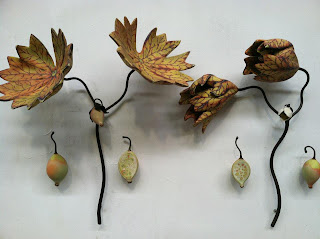 |
| Michael Sherrill’s ceramic artwork |
Ceramist Michael Sherrill has been making pots for more than twenty years. Originally, his work was completely functional, but it has evolved into work that is now wholly sculptural. He is one of the most thoughtful and articulate sculptors of our time.
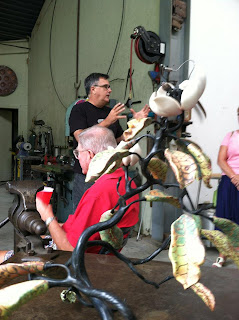 |
| Michael Sherrill talking about his work |
Hoss Haley has worked in metal for over twenty years, creating sculpture, paintings, and public art. Hoss’s work is in several collections including Lowes Corporation,
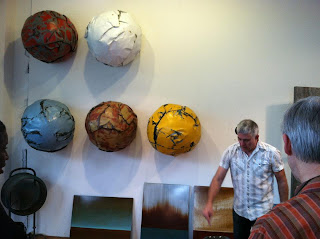 |
| Hoss recycles objects like washing machines and cars – often crumpling them into ball shapes mounted to walls or stacked. |
 |
| Christina Cordova talks about her recent works. |
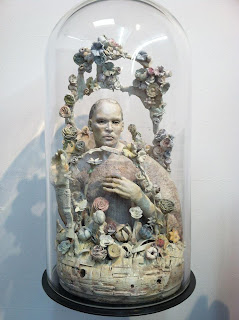 |
| Christina Cordova’s work is awesome. |
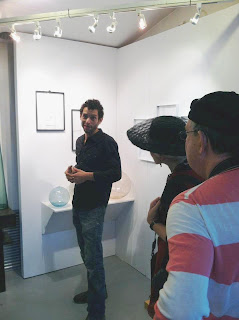 |
| Pablo De Soto charms Fred and Susan Sanders |
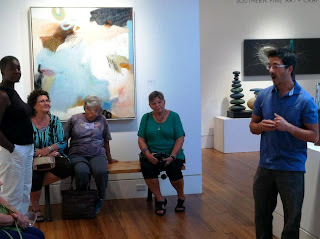 |
| Alex Bernstein talks to the JRA at the Asheville Art Museum. |
Dan Essig’s wordless works of art are sewn, woven and carved into magnificent artists’ books and sculptures. Dan’s works incorporates so many things -fossils, shells, coins and old nails—into his artwork.
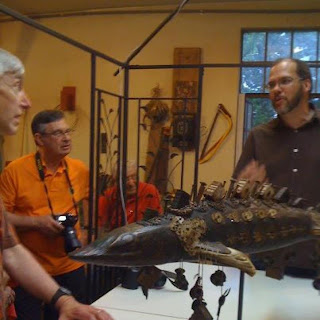 |
| Dan Essig talks of his work |
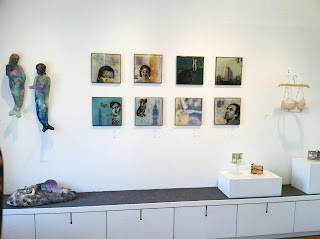 |
| A view of the Blue Spiral 1 Gallery. |
 |
| Stoney shows some of the special woods that Fleur Bresler had sourced. |
 |
| Stoney talked of his process to the tour. |
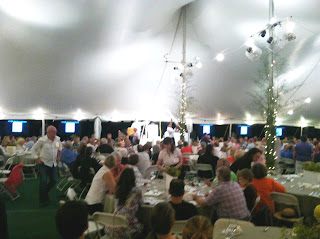 |
| The big show was the drama, anticipation and socializing at the Penland Auction. |
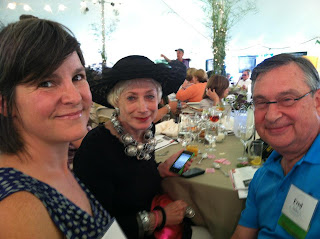 |
| Glass sculptor Beth Lipman chats with Susan and Fred Sanders |
Dan Clayman with the proud owners of his Penland auction piece….Giselle and Ben Huberman
"Elements of 21st Century Reliquaries" Sculpture Class
>
The two DC area superstar sculptors have teamed up to teach a special sculpture class – Elements of 21st Century Reliquaries.
 Novie draws on her archeology training as she creates ceramic houses, books, birds, boats and reliquaries, many that look as though they might have been unearthed on an archeological dig. She explores ideas of nest/hive/home over and over in the work.
Novie draws on her archeology training as she creates ceramic houses, books, birds, boats and reliquaries, many that look as though they might have been unearthed on an archeological dig. She explores ideas of nest/hive/home over and over in the work.
“…I often use archetypal symbols taken from ancient myths and tales. These iconic images take many forms: the bird as harbinger and messenger, bones as touchstones of quiet power, the forest as a threshold to the unknown. These symbols are used to express such universal human experiences as love, loss, fear, death, courage and transformation.” Novie Trump
 Mixed media/video artist Tim Tate uses blown glass jars to capture universal emotions and experiences with haunting video reliquaries that push the boundaries between fine art and fine craft. Tim’s sculptures ask you to surrender your guarded self and feel the range of emotions that they provoke.
Mixed media/video artist Tim Tate uses blown glass jars to capture universal emotions and experiences with haunting video reliquaries that push the boundaries between fine art and fine craft. Tim’s sculptures ask you to surrender your guarded self and feel the range of emotions that they provoke.
“Revelation — and in some cases self-revelation, is the underlying theme of my electronic reliquaries. But the important revelations here are in the viewer’s response to my hybrid art form and its conceptual nature. I try to bare everything — the guts of my materials and my inner thoughts — in deceptively simple narrative videos set into specimen jars. These works are phylacteries of sorts, the transparent reliquaries in which bits of saints’ bones or hair — relics — are displayed. In many cultures and religions, relics are believed to have magical or spiritual powers, especially for healing. My relics are temporal, sounds and moving images formally enshrined, encapsulating experiences like cultural specimens. And perhaps, to the contemporary soul, they are no less reliquaries than those containing the bones of a saint.” Tim Tate
| Instructor | Tim Tate, Novie Trump |
| Dates | Sat/Suns in July/Aug (July 14,15,21,22,28,Aug 4,11) |
| Time | 1pm to 5pm |
| $600 |
Interested? Click HERE to jump to the Washington Glass School online schedule. Novie Trump is a sculptor whose work is in public and private collections throughout the United States and Europe. Her ceramic sculpture has been selected for juried and invitational exhibitions and has been featured in books and publications. She is the founder and director of Flux Studios, a studio in Mount Rainier, MD
Novie Trump is a sculptor whose work is in public and private collections throughout the United States and Europe. Her ceramic sculpture has been selected for juried and invitational exhibitions and has been featured in books and publications. She is the founder and director of Flux Studios, a studio in Mount Rainier, MD
Tim Tate is a Washington, DC native, and has been working with glass as a sculptural medium for the past 25 years. Co-Founder of the Washington Glass School, Tim’s work is in the permanent collections of a number of museums, including the Smithsonian’s American Art Museum, Renwick Gallery and the Mint Museum. He was the recipient of the 2009 Virginia Groot Foundation award for sculpture. He is a 2012 Fulbright Scholar recipient and was Artist-In-Residence at the Institute for International Glass Research (IIRG) in the UK.
Getting GAS’d Up – Glass Art Society Conference Opens in Toledo
> In recognition of the Toledo Museum of Art’s role as the cradle of the American Studio Glass Movement, GAS will be holding its 2012 conference in Toledo, Ohio, June 13 – 17, 2012.
In recognition of the Toledo Museum of Art’s role as the cradle of the American Studio Glass Movement, GAS will be holding its 2012 conference in Toledo, Ohio, June 13 – 17, 2012.
Toledo is welcoming again artists from around the world to celebrate the achievements of the past and to explore the seemingly endless possibilities of glass. Professor Tim Tate will be on a panel with Matthew Szosz, Alexander Rosenberg and moderated by Andrew Page. The discussion is titled: Post Studio Glass and will discuss how:
The work in glass being shown in galleries and art fairs still focuses on formalist object on a plinth. A new generation of glass artists is breaking with the existing glass art field to apply new strategies. Panelists speak with GLASS Quarterly editor Andrew Page about this generational shift and its implications.
| POST STUDIO GLASS PANEL A Look at the New Parameters for Work in Glass Saturday,June 16 at 1:45-3:15pm in the Seagate rooms 202-208 |
|||
Click HERE for the conference program pdf.
Blue Spiral 1 Gallery Looks to Studio Glass’ Future
>North Carolina’s Asheville was named one of AmericanStyle magazine’s “Top 25 Arts Destinations” . This week, another of its top galleries – this time Blue Spiral 1 – opens a show that looks to honor the 50th Anniversary of the American Studio Glass Movement.
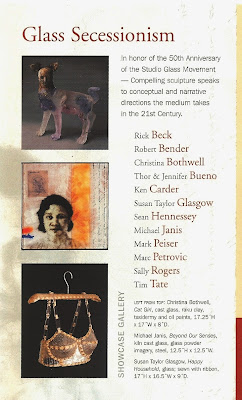 |
| WGS is well represented in the list of artists! |
Blue Spiral has curated the show with an eye to the future of glass with “compelling sculpture [that] speaks to conceptual and narrative directions the medium takes in the 21st Century”.
Artists include a number from the Washington Glass School extended family – Tim Tate, Sean Hennessey, Michael Janis, Marc Petrovic, Christina Bothwell and Susan Taylor Glasgow.
With Erwin Timmers’ work showing at nearby Bender Gallery – its like a Washington Glass School summer camp in the Blue Ridge Mountains!
“Glass Secessionism“
June 7 – July 26, 2012
Opening Reception, June 7, 5-8 pm
Blue Spiral 1 Gallery
38 Biltmore Avenue
Asheville, NC 28801
Habatat Galleries Michigan 40th International Invitational
>
April 26 to May 26, 2012
 |
|
TIM TATE Mermaids Past Their Prime Blown & Cast Glass, original video |
 |
| SUSAN TAYLOR GLASGOW Chandelier Dress II |
In its “Off” position, the chandelier dress rests on a chrome dress form stand and it is lit by 8 bulbs around the skirt, as well as one bulb at the finial.
Habatat Galleries
Chrysler Museum of Art Glass Studio Workshop
>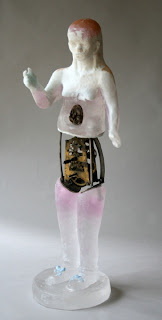
The Chrysler Museum of Art in Norfolk, VA is offering an exciting new dynamic duo – everybody’s favorite ceramic/glass artist Christina Bothwell and our own Professor Pangloss (Panglass?) Tim Tate. The five day workshop runs from May 30 thru June 3.
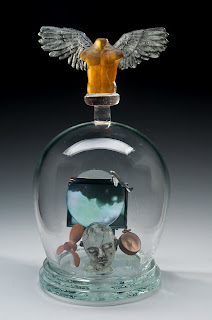
Take advantage of a rare opportunity to learn from two working studio artists that have much to share. Discover the techniques and influences behind the works of Christina Bothwell and Tim Tate, both former winners of the Virginia A. Groot Foundation Award for Sculpture. Bothwell’s work often combines clay and lost wax casting in a figural narrative, while Tate’s art focuses heavily on mixed-media electronics and lost wax casting. Demos will include lost wax casting, open face molds, and casting voids in artwork. Students, whether beginners or experienced glass artists, will have time to work in the Studio, but will benefit most from the group discussions of each student’s work and how to advance to another level in expressing their creativity in glass.
Click HERE to jump to the Chrysler Museum’s site for more info about their workshops.
Dinner with the Board of University of Sunderland and More Workshops!
>
Artist Jeffrey Sarmiento popped into the University of Sunderland’s Architectural Glass studio where our Fulbright workshop classes were being held with an invitation to show how he uses the National Glass Center’s waterjet to cut intricate and delicate glass elements for his artwork. Naturally, I was excited to see 1.) how the waterjet works and 2.) Jeffrey at work.
Jeffrey Sarmiento and Michael Janis
Jeffrey offered to make one of the component layers for the demo piece I was using to show how the sgraffito process can be achieved in glass, and he explained the process. We looked thru some of his images that were in the computer to save time, and selected one of his images of the nearby Tyne bridge that was part of his series “Invisible Cities“.
Jeffrey checks on the initialization of the process.
The pressurized water cuts through the glass and wood support panel.
The grit overflow tub.
The compressor unit located beyond the waterjet machinery.
The verticals of the waterjet cut Bullseye glass panel section are 3mm (less than 1/8″) thick.
Jeffrey pulls apart and assembles the positive and negative.
The connector nibs are pulled off each element.
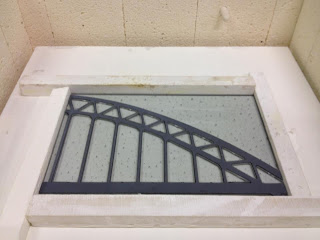
The panels section loaded and fused in the kiln.
The fired panel integrated into the demo piece.
Washington Glass Fulbright duo of Michael Janis & Tim Tate (plus Kay Janis as chaperone) soldiered on with dinner at the National Glass Centre, hosted by the University of Sunderland Board of Directors. The food at the dinner was a treat – my first Yorkshire Pudding. I was told that Yorkshire pudding and was told the story that the origins of the dish was to provide a cheap way to fill the diners – thus stretching a lesser amount of the more expensive ingredients as the Yorkshire pudding was traditionally served first. The dinner was nothing but elegant.
L-R Fulbright Scholar Tim Tate; Graeme Thompson, Dean of Faculty of Arts, Design and Media; Dr Kevin Petrie, Leader of Glass & Ceramics; (not shown in photo Shirley Atkinson, Deputy Vice-Chancellor; Peter Fidler CBE Vice Chancellor & Chief Executive and James Bustard, Director of the NGC).
The Yorkshire Pudding served.
L-R Cathy Barnes, Chair of the NGC Board; Kay Janis; Chris Jobe, Governor of the Board
Though not “lite” in the sense of calories, it was a delectable, light dessert that was served.
It was a lovely, fun evening that was filled with discussions on how we can create opportunities in both countries that would facilitate the exchange artists, ideas and ways we can strengthen the relationships we have developed.
We had time for one more workshop, held at Sunderland’s not-for-profit artist center, Creative Cohesion. This was to be a much more casual workshop, more a conversation – about the differences in the perceived US and the UK approach towards art and education, the changes that social media had on the art world, how artists can survive in tough economic times, the advantages of creating artist covenants.
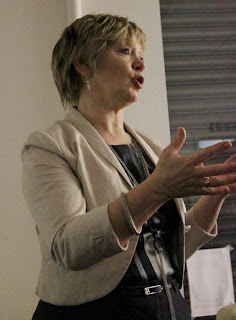
Anne Tye, the Creative Industries Development Manager at Sunderland City Council introduces Tim and Michael to a packed audience.


The talks were packed with artists from Sunderland, Newcastle – as far away as Edinburgh, Scotland.
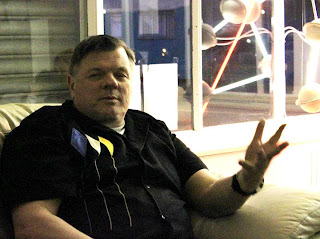
Tim Tate tells all.
The evening talk was the last of our scheduled Fulbright Scholar events. Our short project length had us fly out of town the next morning, heading back to Washington very early.
UK Artist profiles Part 3:
Andrew Livingston
Andrew Livingston works as an artist and is also Leader of CARCuos Ceramic Arts Research Center and MA Ceramics Program Leader at the University of Sunderland, The National Glass Center, Sunderland, UK.
Andrew’s work uses a range of media which acknowledges the interface between both traditional practice and new media. His continued exploration aims to challenge and expand contemporary locations in respect of the traditional positioning of ceramics. The integration of digital media and new technologies has become central to his artwork where new media is often positioned and juxtaposed with more traditional elements.
Andrew’s Parallax View series works in creating a fresh perspective on Tullie House‘s porcelain collection and explores preconceived notions of ceramics.
Surfeit 621 621 cast ceramic components, looped video, and drawings made from clay & graphite.
Britannia. ceramic and glass vitrine.
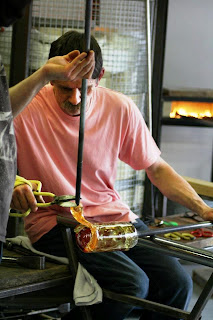
Roger Tye graduated from Manchester Poly in 1975 with a BA(Hons) in 3D Design – Glass and Metal. Roger to concentrate his work on sculptural and installation pieces that integrated glass and other media. Roger is the guiding force of the new not-for-profit artist studio – Creative Cohesion, located in Sunderland. Though Roger often works in creating beautiful traditional blown glass forms, he also works with slate and cast glass.

glass and slate
cast glass sheep, slate and steel
Click HERE to jump to first posting about the Sunderland trip.
London Affordable Art Fair & Imagery In Glass
>
The first big workshop, Bas-Relief dry plaster casting at the UK’s National Glass Center had gone well (phew!) The Sunderland arts organization, Creative Cohesion, was participating in the London Affordable Art Fair and had invited Tim Tate and I to exhibit our work in the contemporary art show. Which we readily agreed. Tim, my wife Kay & I jumped on a train down to London, and joined the exhibitors at the fair that had opened a couple of days earlier.
Kay Janis watches the North Sea whizz by on the train to London.
Crowd watching is part of the fun of an art fair and at London AAF it included celebrity-sightings of Johnny Depp and Joanna Lumley (Joanna looks loverly, BTW)
Tim Tate’s artwork was featured in the Creative Cohesion Booth.
L-R Dinner with the Creative Cohesion artists Kay Janis, Tim Tate, Robyn Townsend, Joanne Mitchell, Roger Tye, Anne Tye
Tim Tate tuckered out on return train trip.
Our time in London was too short, soon we were back on the train to Sunderland, and preparing for my multi-day class “Imagery in Glass” that was held in the Architectural Glass Studio of the National Glass Center.
Outlining the basics for getting detailed imagery into fused glass.
Showing the different glass powder tools and how an artist can manipulate imagery.
The master level class is tasked with creating a number of sample panels.
Students drew inspiration from the view over the river.
The first firing of glass powder imagery.
Reviewing fused glass samples with class.
Discussing options for creating effects within the layered imagery.
Jeffrey Sarmiento created a component layer for the class demo project – the artwork suggests creating bridges between the art communities.
Jeffrey Sarmiento was recently appointed Reader in Glass at the National Glass Center at the University of Sunderland. A Filipino-American artist, he holds an MFA in Glass from the Rhode Island School of Design. His research has led him to work widely in the US and Europe, having been awarded a Fulbright Scholarship Denmark. He was also a finalist for the Louis Comfort Tiffany Award and the Bombay Sapphire Prize. His most recent project is a 600kg glass map, permanently housed in the new Museum of Liverpool.
Liverpool Map Jeffrey Sarmiento and Inge Panneels, 2010
Bombay Encyclopedia
Jeffery Sarmiento talks about his work “Ossify”
Ossify 2010 British Glass Biennale Award Runner up

Emotional Leak Jeffrey Sarmiento & Erin Dickson, 2011
Cate Watkinson trained in 3-D Design, Glass with Ceramics at Sunderland Polytechnic.After leaving college Cate worked in Cambridge and the Channel Islands before returning to the North East to set up her architectural glass studio. Cate continues to run her business, Watkinson Glass Associates, while teaching at the University of Sunderland.
Over the years Cate has built on her experience, optimizing developments in new technologies, including new developments and techniques in construction. She has successfully completed a varied range of commissioned projects from glass public seating in city centers to a 22’ high sculpture for a shopping mall. From a stained glass window for Newcastle Cathedral to a laminated glass screen for the Arrivals Hall at Newcastle International Airport in the UK.
Other research activities include exploring the use of text and light through the public art commission entitled `Total Policing’, a glass and stainless steel sculpture situated at the front of the new head quarters for Northumbria Police in North Tyneside.
Total Policing
Baltic Business Quarter Public art/seating made with recycled glass.
Lookout
Next Up – Creative Cohesion artist development talk, dinner with the Uni Board, and more great UK artists!
Fulbright Scholars at University of Sunderland
>
Our Fulbright schedule began to fill the days.The first workshop we held at the University of Sunderland’s National Glass Center: “Affecting Sheet Glass – Bas-Relief Imagery in Glass” was filled. The technique of “dry plaster casing” was outlined, and firing schedules were converted from Fahrenheit to Celsius – along with converting all dimensions from imperial to metric. (Why did the US decide to not join the world in the 70’s when we were supposed to go all metricationed?)
Tim Betterton sets up the kilns for dry plaster casting.
After the firing, its like Christmas day as the students eagerly retrieve their kilnformed glass sculptures.
We were able to meet a number of incredibly talented artists that were associated with the University and their work was so strong that we will post some of the work and profiles about the artists in each of the next few blog updates:
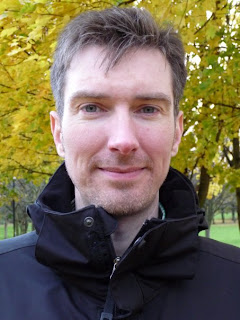
Dr Kevin Petrie leads the Glass and Ceramics department at the University of Sunderland. Kevin studied Illustration at the University of Westminster and Ceramics and Glass at the Royal College of Art. He holds a PhD in ceramics and print from University of the West of England, Bristol. Kevin’s first book ‘Glass and Print’ established the crossovers between Glassmaking and Printmaking. The book forms the cornerstone of a period of research that established the cross over between two largely separate strands of creative activity. His second book, ‘Ceramic Transfer Printing’ draws together the great potential of print for ceramics. Kevin has written many articles and reviews for journals such as Ceramic Review and presented his work on glass, ceramics and print in Canada, Thailand, Hong Kong, Denmark, Germany, USA, Australia, and China. He was recently awarded a National Teaching Fellowship for his contribution to glass and ceramics teaching, in particular this relates to postgraduate at MA, MPhil and Ph.D levels.
Dr Petrie’s work often refers to the long tradition of graphic ceramic surface decoration at the same time as reflecting contemporary life.
St Pauls Church, kilnformed glass
Cell of Himself, Kiln form glass with printed inclusions, blown glass
Besides his own work as an artist, Dr Petrie is an author, lecturer, exhibition curator, and he is an authority and specialist on contemporary glass and ceramics matters. He has lectured at the following institutions: The University of the West of England, Bristol, The University of Westminster, London, Norwich School of Art and Design, Bath Central St. Martins School of Art and Design, London, Rajabhat Institute Changmai, Thailand, Australia National University, Canberra, Australia, Monash University, Melbourne, Australia, Sydney College of the Arts, Australia, Anla Glas, Denmark, Hong Kong Baptist University – Academy of Visual Arts.
__________________________________________________________

If you are familiar with the first of the DC / Sunderland glass exhibition “Glass3” that was held in Georgetown in 2008, you might have seen James Maskrey‘s work. His work has really transformed into haunting and ethereal work. Social situations, overheard conversations, observed interactions and personal experiences hugely inspire Jim’s work. Tall stories, elaborate hoaxes and peculiar facts, usually from a bygone era, are then translated into glass, often resulting in flamboyant narratives, theatrical compositions or simple objects with a twist. The series below are from a series based on the polar expeditions by Edward Wilson to collect penguin eggs.
The Worst Journey in the World, blown and hot sculptured glass details, 2011. Photo by David Williams
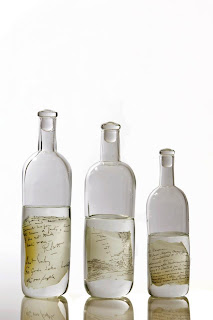

Last Entry,Winter Journey, andThe Barrier, 2011, Blown and solid formed hot glass with printed glass inclusions.
The works poetically and poignantly touches on themes of collecting and hubris. In the austral winter of 1911, Wilson led “The Winter Journey”, a doomed journey to the Emperor penguin’s breeding grounds at Cape Crozier to collect eggs for scientific study. The eggs were supposed to reveal the evolutionary links between dinosaurs and birds but their collection nearly killed the journey’s participants. Frozen and exhausted, they successfully collected three eggs and desperately exhausted they returned to Cape Evans, later describing this expedition “The Worst Journey in the World.”
James started working with glass in 1990. After graduating in 2000 with a Three Dimensional Design BA (Hons) degree in glass at The Surrey Institute of Art and Design he was appointed as Artist in Residence at the Surrey Institute. In 2001 James joined the Glass and Ceramics department at The University of Sunderland and graduated with an MA in Glass with distinction in 2004. Jim was recently named as one of the artists that will exhibit at the British Glass Biennale 2012.
Coming Next – London Affordable Art Fair & Imagery in Glass Class and featured Sunderland Artists: Jeff Sarmiento, Cate Watkinson and more!
